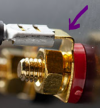In terms of home automation devices you could use for this, without any electronics required....
SOnOff LV.
It's a pre-canned low voltage Wifi switch. ESP8285, supports Tasmota firmware so integrations with the usual stuff the usual ways. The relay is "dry contact" of course. The idea would be to use that one relay to flip your other relays.
In terms of the debate around magnetic fields. The magnetic field is 'static' if we consider the power rail noise as negligible. However. Faraday said a changing current induces a magnetic field around a conductor. Also, that a changing magnetic field induces a current in a conductor. So the magnetic field will be influenced by the changing current of the AC signal line. That said however. If it is a signal line, it will be going between IO ports with 10KOhm or higher impedance. There won't be much current at all. A 1V peak on a line level going into 10KOhm results in 0.0001 amps. 1/10th of a milliamp. However, the relay coil impedance is far far lower than that and will be consuming 10s of mlliamps. I'd suggest if you can measure that, grand, I doubt you'll hear it.
A few tips though.
1. Use "normally closed" relays (or the NC pole) will moot the whole point. The relay "in use" will be OFF when active and the coil field in it will be neutral.
2. Be careful of the relay coil inductive pulse. Make sure your relay board has a flyback/free wheel diode. There would be interesting debate on what effect the collapsing of the inductor magnetic field and it's effect on the audio signal. Although only relevant for the outputs feeding an amp. When you disconnect an input, or discharge the coil in the relay there will be an EMF pulse as the current races (free wheels) backward around the diode. It shouldn't ring for very long, depends on the capacitance of the circuit etc. etc.
What about SSRs?

